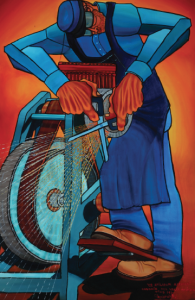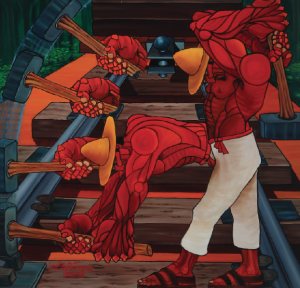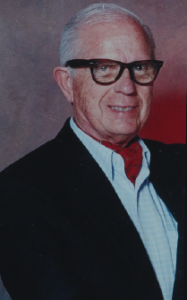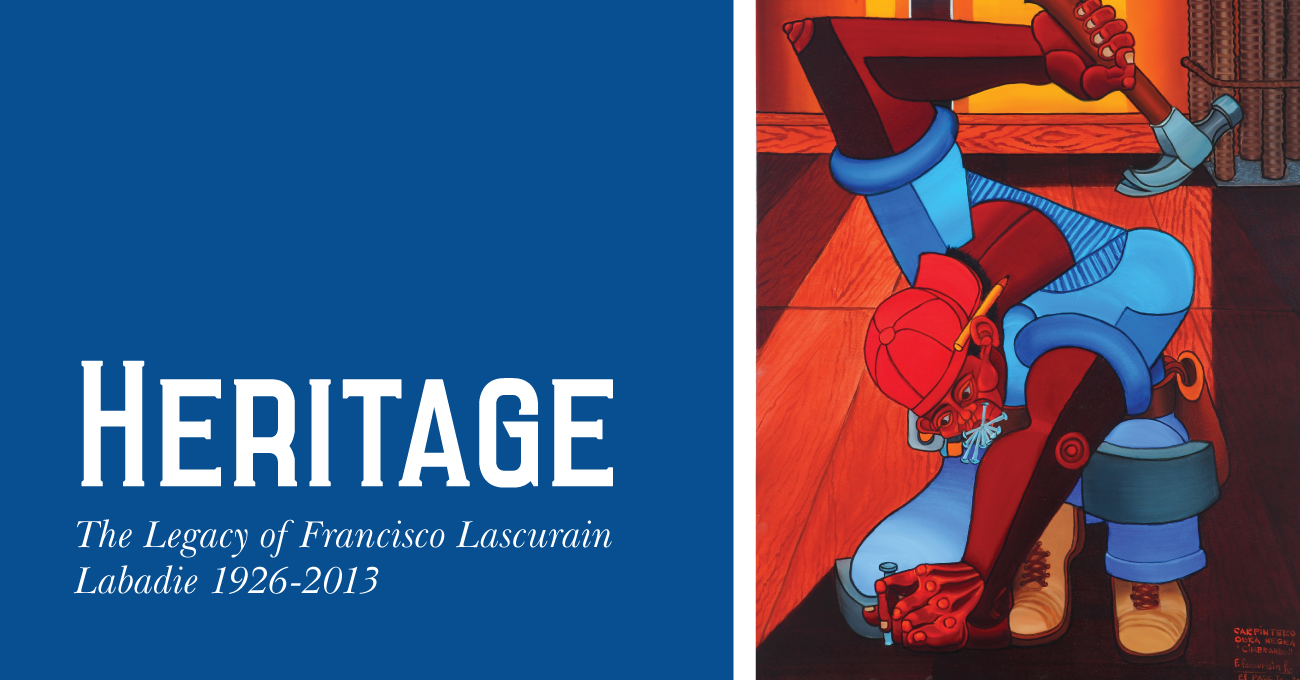Heritage
Photographed by Lencho Guerra
The family of Francisco Lascurain Labadie recently contacted The Art Avenue in an effort to share the artwork of their patriarch that has been behind closed doors for more than 20 years. This artist preferred to be an unknown, quietly afraid people wouldn’t appreciate the subjects he painted. Shortly before he passed in 2013, a videotape was recorded; a biography to his family, which The Art Avenue had translated from Spanish to English with the help of his wife Marisa Lascurain and daughter Veronica Lascurain-Valdez. This is where we learn how Lascurain was born into a prominent family in Mexico City in 1926, grew up with a love of architecture and painting and was fascinated by the common worker in Mexico.

The oldest of five children, Lascurain cultivated friendships in Mexico City with philosophers, writers and artists indigenous to Mexico who were inspirational in his life like Don Jose Vasconcelos, Rufino Tamayo, José Clemente Orozco, Felipe Orlando and Rodolfo Nieto. While they were clearly influential individuals in Lascurain’s life, it was the day laborer—the common workers of the 30s and40s that would eventually catch his heart and his eye.
“As a young boy I was very curious about culture and adventure,” said Lascurain
This curiosity and perhaps a bohemian lifestyle he choose to follow is what prompted his travel to Spain in his late teens and early 20s in search of his ancestral roots where he stayed and studied for several years. It was during this time he met with the great Spanish painter Pablo Picasso.
Lascurain later returned to Mexico where he cultivated his architectural passion and designed works in both Mexico City and eventually in Chihuahua where he later moved in 1984. “My dad was very busy. There were so many people that wanted him to design for them, yet he never wanted to publicize his accomplishments, he was humble,” said Veronica Lascurain-Valdez. It was after much consideration he decided to follow prospective leads towards Ciudad Juarez. Later, with the gentle prompting of his wife Marisa, they moved to El Paso, TX in the mid-80s, so their three children could be educated in the states and learn English.

He was ready for a change, yet it wasn’t an easy move. “My biggest challenge was the language and different laws that govern the architectural field,” said Lascurain through the 20-minute videotape. The codes and rules were different in the U.S., and he would need to go back to school in order to be certified as an architect in the states. To start over again was difficult a choice for Lascurain but he felt his career was slipping away. “I fell victim to frustration and depression,” said Lascurain in the tape. It was only after designing with the architectural firm of Nagee and working on construction projects with John Ivy, was he able to feel more secure in his choice.
When he wasn’t working full-time in commercial design and construction he would retreat to a room in his Westside home and sketch in order to feed his creative side. It was there he had pencil sketches of the bodies, faces and the hands of people, most importantly the people of his home country. “My dad would draw in his sketch book until he had the idea of exactly how he wanted something or someone to look. There would be pages of images—he was trying to perfect a line or a shape—capturing the emotions like only he could remember,” said Lascurain-Valdez. She went on to comment that even in his 70s he had an incredible memory. “He used to tell me stories about growing up in Mexico and the history behind each painting. El Taquero (The Taco Man) was one of the street vendors my dad would see every day. This man would serve tacos, salsa and cervezas to the people in the neighborhood. My dad would follow the workers around: the delivery man with the bread, the milkman, the man who sharpened knives, the meringue cookie vendor and even the bartender at the local pub. He made friends with them all!”

Lascurain took his passion and memories of the urban workers of the 30s and 40s and transferred the genuine love of their jobs into grand works of art. It was a time when technology couldn’t interfere, only humans doing the work of what is an everyday ritual in Mexico. Using warm and rich colors he painted an entire series of 20 pieces related to laborer.
Veronica remembers asking her dad why he would not show his work. She said he always responded, “Maybe later when I have 15…maybe when I have 20 art pieces.” Maybe became 20 and he passed. He never signed his last painting, he never titled his last work of art and he left his family in question of what exactly to do with his private laborer collection he tried so hard to keep close to the heart.
In fact only one painting has truly ever left the house, aside from the handful of artwork in the homes of his daughter and sons. “At a dinner party a little over ten years ago, Dr. Manuel Rivera, one of Fransisco’s friends came over and fell in love with ‘El Aguador,’” explains his wife Marisa. “He pulled out his wallet and wrote a check. My husband would not take the check. He never intended to share his work with anyone outside of the house at that time and never thought a moment on the money—it was never about the money.” By the end of the evening Lascurain parted with the piece and Dr. Rivera is the only non-family member to own an original Francisco Lascurain painting to date.

Lascurain painted his figures with great dimension and always caught his subjects in the act or “working.” Because they were laborers, the hands in each piece received particular attention. He used subtle shades of tan, brown and orange, highlighting the hands with darker tones instead of black to outline the subjects. As time progressed, along with his cancer, he began to insert the image of his own hands into the paintings. As his health deteriorated his hands were metamorphosing, similar to a day laborer busy at work who endures callouses and swollen hands. He couldn’t hold a paintbrush any longer and the hands in the paintings became engorged, yet maintained a sense of their own space; depicting a story of perhaps the laborer and his due diligence, and a man fighting his destiny.
Family members still grieve the loss of their patriarch but are ready to pay tribute to a man they loved and share his paintings. “This exhibit will open doors to the world and allow anyone to discover and appreciate the magic of an era, the feelings of the Mexican people and the wonderful way it was captured on canvas,” said Marisa Lascurain.
The Art Avenue Gallery will be the first gallery to exhibit the great works of Francisco Lascurain Labadie. Visitors will have an opportunity to view nine pieces from his laborer collection and pay homage to a great artist. Heritage is currently on display at The Art Avenue Gallery on 518 W. San Antonio Suite F through January.



